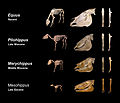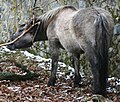Portal:Horses
The Horses PortalThe horse (Equus ferus caballus) is a domesticated, one-toed, hoofed mammal. It belongs to the taxonomic family Equidae and is one of two extant subspecies of Equus ferus. The horse has evolved over the past 45 to 55 million years from a small multi-toed creature, close to Eohippus, into the large, single-toed animal of today. Humans began domesticating horses around 4000 BCE, and their domestication is believed to have been widespread by 3000 BCE. Horses in the subspecies caballus are domesticated, although some domesticated populations live in the wild as feral horses. These feral populations are not true wild horses, which are horses that never have been domesticated and historically linked to the megafauna category of species. There is an extensive, specialized vocabulary used to describe equine-related concepts, covering everything from anatomy to life stages, size, colors, markings, breeds, locomotion, and behavior. Horses are adapted to run, allowing them to quickly escape predators, and possess a good sense of balance and a strong fight-or-flight response. Related to this need to flee from predators in the wild is an unusual trait: horses are able to sleep both standing up and lying down, with younger horses tending to sleep significantly more than adults. Female horses, called mares, carry their young for approximately 11 months and a young horse, called a foal, can stand and run shortly following birth. Most domesticated horses begin training under a saddle or in a harness between the ages of two and four. They reach full adult development by age five, and have an average lifespan of between 25 and 30 years. Horse breeds are loosely divided into three categories based on general temperament: spirited "hot bloods" with speed and endurance; "cold bloods", such as draft horses and some ponies, suitable for slow, heavy work; and "warmbloods", developed from crosses between hot bloods and cold bloods, often focusing on creating breeds for specific riding purposes, particularly in Europe. There are more than 300 breeds of horse in the world today, developed for many different uses. (Full article...) Entries here consist of Good and Featured articles, which meet a core set of high editorial standards.
Ruth Elizabeth "Bazy" Tankersley (née McCormick, formerly Miller; March 7, 1921 – February 5, 2013) was an American breeder of Arabian horses and a newspaper publisher. She was a daughter of U.S. Senator Joseph Medill McCormick. Her mother was progressive Republican U.S. Representative Ruth Hanna McCormick, making Tankersley a granddaughter of Senator Mark Hanna of Ohio. Although Tankersley was involved with conservative Republican causes as a young woman, including a friendship with Senator Joseph McCarthy, her progressive roots reemerged in later years. By the 21st century, she had become a strong supporter of environmental causes and backed Barack Obama for president in 2008. Tankersley's father died when she was a child. When her mother remarried, the family moved to the southwestern United States, where Tankersley spent considerable time riding horses. She became particularly enamored of the Arabian breed after she was given a part-Arabian to ride. At the age of 18, she began working as a reporter for a newspaper published by her mother. She later ran a newspaper in Illinois with her first husband, Peter Miller. In 1949, she became the publisher of the conservative Washington Times-Herald. That paper was owned by her uncle, the childless Robert McCormick, who viewed Tankersley as his heir until the two had a falling out over editorial control of the newspaper and her relationship with Garvin Tankersley, who became her second husband. After The Washington Post absorbed the Times-Herald, she shifted to full-time horse breeding. (Full article...)Selected image A 1900 photograph of three Piegan (Blackfeet) Indian chiefs. When Iberian horses were obtained from the Spanish, the Plains tribes rapidly integrated them into their daily lives. By the early 18th century some tribes had fully adopted a horse culture. Latest updates
More did you know?
Related portalsEntries here consist of Good and Featured articles, which meet a core set of high editorial standards.
 The Narragansett Pacer was one of the first recorded horse breeds developed in the United States. It emerged in the 18th century (1700s), and was theorized to have been bred from a mix of English and Spanish breeds, although the exact cross is unknown. The Pacer was associated with, and bred in, the state of Rhode Island and the area of New England; as horse breeding shifted to Kentucky and Tennessee in the late 1700s, it became extinct by the 20th century. Narragansett Pacer horses were owned and ridden by many famous people of the American Revolutionary War era, including President George Washington, Paul Revere, and others. The last known purebred Pacer is thought to have died around 1880, though the breed disappeared earlier from pedigrees in the late 1700s or early 1800s. (Full article...)Did you know (auto-generated)
General imagesThe following are images from various horse-related articles on Wikipedia.
TopicsHorse • Pony • Asinus • Equus (genus) • Equidae • Zebra • Glossary of equestrian terms • List of horse breeds • Evolution of the horse • Domestication of the horse • Horse care • Stable • Horse training • Equestrianism • Horse tack • Saddle • Equine nutrition • Equine anatomy • Equine conformation • Equine coat color • Equine coat color genetics • Horse markings • Equine vision • Horse hoof • Horseshoe • Horse gait • Horse behavior • Horse breeding • Breed registry • Equine infectious anemia • Horse colic • Lameness • Laminitis • Horse slaughter • Horses in warfare • Arabian horse • Thoroughbred SubcategoriesNew articlesThis list was generated from these rules. Questions and feedback are always welcome! The search is being run daily with the most recent ~14 days of results. Note: Some articles may not be relevant to this project.
Rules | Match log | Results page (for watching) | Last updated: 2024-05-12 20:09 (UTC) Note: The list display can now be customized by each user. See List display personalization for details.
WikiProjectsAssociated WikimediaThe following Wikimedia Foundation sister projects provide more on this subject:
Discover Wikipedia using portals |


























































